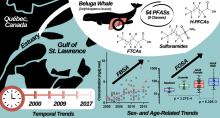| Title | Multigenerational Effects and Demographic Responses of Zebrafish ( Danio rerio) Exposed to Organo-Bromine Compounds. |
| Publication Type | Journal Article |
| Year of Publication | 2018 |
| Authors | Ma, Z, Peng, H, Jin, Y, Zhang, X, Xie, X, Jian, K, Liu, H, Su, G, Tang, S, Yu, H |
| Journal | Environ Sci Technol |
| Volume | 52 |
| Issue | 15 |
| Pagination | 8764-8773 |
| Date Published | 2018 Aug 07 |
| ISSN | 1520-5851 |
| Abstract | Long-term exposure to toxic chemicals often has deleterious effects on aquatic organisms. In order to support appropriate environmental management of chemicals, a mathematical model was developed to characterize the effects of chemicals on multigenerational population dynamics in aquatic animals. To parametrize the model, we conducted a multigenerational laboratory toxicity test in zebrafish ( Danio rerio) exposed to 2-bromo-4,6-dinitroaniline (BDNA). Long-term exposure to BDNA considerably reduced the fecundity of adult zebrafish (F and F) and caused deformities in the offspring (F). Life history data, including changes in fecundity and population growth, were then integrated into the model to predict population dynamics of zebrafish exposed to two novel brominated flame retardants, bis(2-ethylhexyl)-2,3,4,5-tetrabromophthalate (TBPH) and 2-ethylhexyl-2,3,4,5-tetrabromobenzoate (TBB). The model predicted that the fecundity of adult zebrafish would be significantly impaired after exposure to 90.36 μM TBPH and 99.16 μM TBB. Thus, prolonged exposure to such levels over multiple generations could result in population extinction within 20 years. Our results provide an intensive temporal perspective to investigate a keystone that connects with individual response to chemicals, population dynamics, and ultimately ecosystem influences. |
| DOI | 10.1021/acs.est.8b00569 |
| Alternate Journal | Environ. Sci. Technol. |
| PubMed ID | 29984988 |
Environmental Chemical Biology

